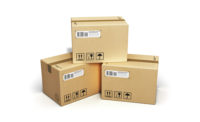6 steps to successful retail-ready packaging implementation
Transitioning to RRPs is a journey, and there’s no one-size-fits-all solution.

Corrugated boxes are vital in today’s economy. They are responsible for safely transporting products and purchases to retail stores and front doors. Historically, traditional brown shippers have been the norm for secondary packaging, however, the box has recently been experiencing an evolution driven by retail initiatives that yield more efficient in-store operations and better retail presentation.
The shift to more streamlined secondary package designs, referred to as “retail-ready” or “shelf-ready” packaging, is being driven by major retailers. While this trend started a few decades ago in parts of Asia and Europe, retail-ready package (RRP) designs and packaging equipment is gaining significant traction in the United States. Until recently, retailers were not paying close attention to the benefits provided by retail-ready packaging. Vertically integrated retailers in the United States have been the catalyst for change in secondary packaging design, by first converting their owned brands to RRPs and now implementing that change throughout store shelves.
Studies, such as the one conducted by The Freedonia Group, Cleveland, Ohio, project that the demand for retail-ready corrugated boxes will increase to $3.3 billion per year by 2020. As adoption of RRP solutions continues to grow at the retail shelf level, food and product manufacturers feel greater pressure in adapting and implementing RRPs for their products. However, many in the industry don’t know where to turn for help in implementing RRPs or understand what variations of RRP designs exist.
Here are six sure-fire steps to help you and your organization successfully implement retail-ready packaging.
- What makes a secondary package a retail-ready package?
A basic understanding of retail-ready packaging is critical, so at the very least, know what to look for when considering a retail-ready solution that best fits your product. A simple Google search results in thousands of varying definitions, but the overarching agreement is that an RRP must meet five critical requirements. These five requirements are also the guiding characteristics that retailers include in their packaging guidelines given to all their vendors.
These five characteristics include:
Easy to identify. RRPs must be easy to identify on a crowded congested storage shelves, and they must have recognizable labeling.
Easy to open. Store associates must be able to open the RRP quickly and without the use of a knife, whenever possible.
Easy to stock. RRPs must be simple enough to allow all employees to quickly replenish shelves. The retail-ready package dimensions should match the shelf they are being displayed on.
Easy to shop. Customers must be able to conceptualize and access the product, with no barriers such as folded flaps or wrapping.
Easy to dispose. RRPs should be manufactured from a paper-based material whenever possible to allow for recycling at the end of life.
- What do you need your box to do for you?
A box is just a box, right? Well, not exactly. Shippers must work in hostile work environments, hold up against varying temperatures and humidity levels and carry up to 10 times its weight. Additionally, it needs other useful skills to make it retail-ready, like the five characteristics highlighted in Step No. 1, as well as the ability to display, ease of storage, stocking speed and brand messaging. Finally, these retail-ready shippers must be able to ship without damaging the section of the box that ends up on store shelves, which is commonly referred to as the tray.
These days, boxes are required to do much more than transport items. To ensure your RRP design will meet the product’s unique needs, a useful step is to write down all the requirements you need your package to accomplish. Requirements may change between retail stores, so you may need separate lists. Also, don’t forget any federal mandates that your package must adhere to, depending on the product.
- What are your options?
Once you’ve reached Step No. 3, you should have learned what qualifies a secondary package as a retail-ready one, and you’ve figured out what’s needed for your RRP. The next step is to understand the options available for your product’s primary package. For instance, products that are in pouches will have different needs and preferred designs compared to products in cans.
Whether your product is being packed in a flexible or rigid primary package has a significant impact on overall case weight. Tubs and bottles are heavier than pouches, and will require an RRP design that boasts higher palletizing strength to ensure products aren’t damaged during distribution.
Some resources reference useful charts to identify available RRP design options. You can also connect with your existing corrugated supplier or packaging equipment provider to discuss options.
- What will it cost?
The most unavoidable but important question that will be asked when looking at transitioning to an RRP is what will it cost. Often the answer isn’t as easy as calculating capital and material costs, but will rather depend on who is looking at an RRP solution and whose profits and losses the costs line up to.
There will be material costs and possible equipment costs involved, but it is important to look beyond how much money you’ll dole out initially. Often cost offsets occur when implementing an RRP solution such as increased pallet packing capacity through a smaller RRP design that allows for more product per layer, more warehouse space and reduced handling, which lowers operating costs.
Additional ways to offset costs with an RRP redesign can be achieved on the store shelf as well. Retailers and producers are being asked to better maximize the space allowed for them on the shelves. In the past, product was loose and there was extra shelf space in the back, but with retail-ready trays, or some form of tray, items are using every centimeter they’re given. Maximizing shelf depth is a major initiative for retailers, and switching to a shelf-ready design that uses as much space as possible will make your retailers happy.
Maximizing shelf space isn’t the only benefit you can anticipate with RRPs. Often sales can benefit as well with a display tray that helps maximize product presentation in the aisle. You can design and brand the display tray to help customers more easily identify products on the shelf, pick out different flavors and read essential brand messages and product information. Additionally, products that traditionally lay flat on the shelf can be presented vertically in an RRP display for easier identification. For example, one frozen pizza company saw sales double after implementing an RRP that enabled the pizza to sit upright in the freezer.
- What to do with your suppliers?
When transitioning to RRPs, don’t overlook your corrugated and packaging equipment supplier.
A critical component to the design of an RRP solution is the type of corrugate material you use. Ensuring that the corrugate has the proper strength to hold up through the entire distribution network can save headaches later in the transition process.
Similarly, equipment is a critical component to successful RRP implementation. Depending on your plants and existing equipment, your current packaging machines may not be able to adopt modern RRP designs. On occasion, some secondary equipment packaging manufacturers have upgrades and enhancements that can be installed to existing machines. However, be sure to understand if these upgrades are only short-term fixes.
Thinking only in the short term can greatly hinder an organization’s ability to evolve as business needs evolve. Planning for future equipment needs will help ensure business is well positioned to adapt to future demands. As you formulate an RRP implementation plan, lay out your plan of action over three timelines.
- Short term. What can I do now or in the next couple of months?
- Intermediate term. Thinking 6-12 months out where you might require change parts, might need to move existing lines into different positions or adjust lines.
- Long term. Consider the extended future, more than a year from now. Do you need to make capital investments to your lines? Do you need changeover flexibility or automation to your packaging equipment?
Discuss and schedule effectively, so that your customer base can accept product during the RRP transition. For example, it’s better for brand recognition and customer clarity to roll out the new RRPs at one time, rather than in multiple stages.
- How to sell it internally?
Embarking on a significant packaging redesign will no doubt require multiple levels of approval within the business. To effectively receive permission, make sure you have gathered evidence for why the RRP is important and how the business can benefit.
Before you present to your leadership team, be sure to cover these critical steps:
- Align with internal teams who you’ll need support from.
- Share what you’ve learned with your internal teams. Sharing knowledge and educating teams can be critical in gaining their support.
- Examine how you will need to sell this internally such as who will you need to present to and what kind of information would that individual be seeking.
- Dig into estimates for savings and cost offsets. What will the reduction in storage be? How much extra shelf space will you be utilizing? What material savings will this create?
- Establish a good line of communication with your sales teams who are calling on major retailers. The better line of communication, the greater the chance you can make allies.
To prepare, assemble your slides, scheduling meetings and consider what questions might be asked of you and how you will address them. Here are some common questions that will likely be addressed when discussing RRP implementation:
- How much will this cost?
- Why is it important to do now?
- Do we have to change existing equipment?
- What is the lead time for the required changes?
- What additional opportunities could this new package design bring?
- How can we protect our investment from future change requests from the retailers?
Transitioning to RRPs is a journey, and there’s no one-size-fits-all solution. To be effective in this step, tie it all together and highlight how you can gain efficiency through RRPs. Get labor, cost and manufacturing all in check before presenting to your leaders.
There is no quick way to success when implementing RRPs. It requires multiple steps, coordination and buy-in between multiple levels within an organization to achieve retail-ready success.
Looking for a reprint of this article?
From high-res PDFs to custom plaques, order your copy today!




